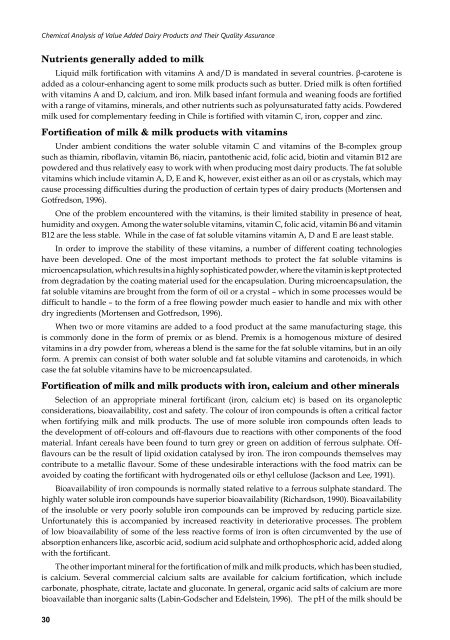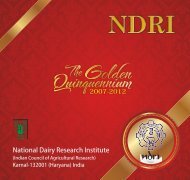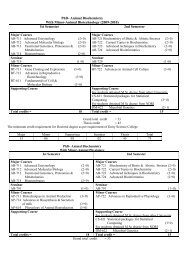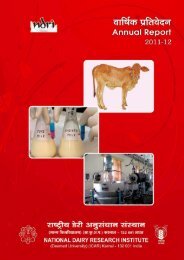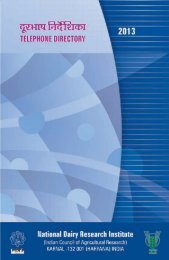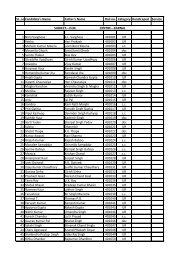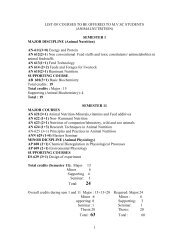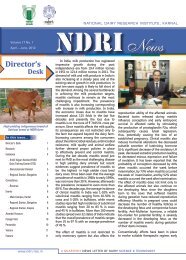Chemical Analysis of Value Added Dairy Products and Their Quality ...
Chemical Analysis of Value Added Dairy Products and Their Quality ...
Chemical Analysis of Value Added Dairy Products and Their Quality ...
You also want an ePaper? Increase the reach of your titles
YUMPU automatically turns print PDFs into web optimized ePapers that Google loves.
<strong>Chemical</strong> <strong>Analysis</strong> <strong>of</strong> <strong>Value</strong> <strong>Added</strong> <strong>Dairy</strong> <strong>Products</strong> <strong>and</strong> <strong>Their</strong> <strong>Quality</strong> AssuranceNutrients generally added to milkLiquid milk fortification with vitamins A <strong>and</strong>/D is m<strong>and</strong>ated in several countries. β-carotene isadded as a colour-enhancing agent to some milk products such as butter. Dried milk is <strong>of</strong>ten fortifiedwith vitamins A <strong>and</strong> D, calcium, <strong>and</strong> iron. Milk based infant formula <strong>and</strong> weaning foods are fortifiedwith a range <strong>of</strong> vitamins, minerals, <strong>and</strong> other nutrients such as polyunsaturated fatty acids. Powderedmilk used for complementary feeding in Chile is fortified with vitamin C, iron, copper <strong>and</strong> zinc.Fortification <strong>of</strong> milk & milk products with vitaminsUnder ambient conditions the water soluble vitamin C <strong>and</strong> vitamins <strong>of</strong> the B-complex groupsuch as thiamin, rib<strong>of</strong>lavin, vitamin B6, niacin, pantothenic acid, folic acid, biotin <strong>and</strong> vitamin B12 arepowdered <strong>and</strong> thus relatively easy to work with when producing most dairy products. The fat solublevitamins which include vitamin A, D, E <strong>and</strong> K, however, exist either as an oil or as crystals, which maycause processing difficulties during the production <strong>of</strong> certain types <strong>of</strong> dairy products (Mortensen <strong>and</strong>Gotfredson, 1996).One <strong>of</strong> the problem encountered with the vitamins, is their limited stability in presence <strong>of</strong> heat,humidity <strong>and</strong> oxygen. Among the water soluble vitamins, vitamin C, folic acid, vitamin B6 <strong>and</strong> vitaminB12 are the less stable. While in the case <strong>of</strong> fat soluble vitamins vitamin A, D <strong>and</strong> E are least stable.In order to improve the stability <strong>of</strong> these vitamins, a number <strong>of</strong> different coating technologieshave been developed. One <strong>of</strong> the most important methods to protect the fat soluble vitamins ismicroencapsulation, which results in a highly sophisticated powder, where the vitamin is kept protectedfrom degradation by the coating material used for the encapsulation. During microencapsulation, thefat soluble vitamins are brought from the form <strong>of</strong> oil or a crystal – which in some processes would bedifficult to h<strong>and</strong>le – to the form <strong>of</strong> a free flowing powder much easier to h<strong>and</strong>le <strong>and</strong> mix with otherdry ingredients (Mortensen <strong>and</strong> Gotfredson, 1996).When two or more vitamins are added to a food product at the same manufacturing stage, thisis commonly done in the form <strong>of</strong> premix or as blend. Premix is a homogenous mixture <strong>of</strong> desiredvitamins in a dry powder from, whereas a blend is the same for the fat soluble vitamins, but in an oilyform. A premix can consist <strong>of</strong> both water soluble <strong>and</strong> fat soluble vitamins <strong>and</strong> carotenoids, in whichcase the fat soluble vitamins have to be microencapsulated.Fortification <strong>of</strong> milk <strong>and</strong> milk products with iron, calcium <strong>and</strong> other mineralsSelection <strong>of</strong> an appropriate mineral fortificant (iron, calcium etc) is based on its organolepticconsiderations, bioavailability, cost <strong>and</strong> safety. The colour <strong>of</strong> iron compounds is <strong>of</strong>ten a critical factorwhen fortifying milk <strong>and</strong> milk products. The use <strong>of</strong> more soluble iron compounds <strong>of</strong>ten leads tothe development <strong>of</strong> <strong>of</strong>f-colours <strong>and</strong> <strong>of</strong>f-flavours due to reactions with other components <strong>of</strong> the foodmaterial. Infant cereals have been found to turn grey or green on addition <strong>of</strong> ferrous sulphate. Offflavourscan be the result <strong>of</strong> lipid oxidation catalysed by iron. The iron compounds themselves maycontribute to a metallic flavour. Some <strong>of</strong> these undesirable interactions with the food matrix can beavoided by coating the fortificant with hydrogenated oils or ethyl cellulose (Jackson <strong>and</strong> Lee, 1991).Bioavailability <strong>of</strong> iron compounds is normally stated relative to a ferrous sulphate st<strong>and</strong>ard. Thehighly water soluble iron compounds have superior bioavailability (Richardson, 1990). Bioavailability<strong>of</strong> the insoluble or very poorly soluble iron compounds can be improved by reducing particle size.Unfortunately this is accompanied by increased reactivity in deteriorative processes. The problem<strong>of</strong> low bioavailability <strong>of</strong> some <strong>of</strong> the less reactive forms <strong>of</strong> iron is <strong>of</strong>ten circumvented by the use <strong>of</strong>absorption enhancers like, ascorbic acid, sodium acid sulphate <strong>and</strong> orthophosphoric acid, added alongwith the fortificant.The other important mineral for the fortification <strong>of</strong> milk <strong>and</strong> milk products, which has been studied,is calcium. Several commercial calcium salts are available for calcium fortification, which includecarbonate, phosphate, citrate, lactate <strong>and</strong> gluconate. In general, organic acid salts <strong>of</strong> calcium are morebioavailable than inorganic salts (Labin-Godscher <strong>and</strong> Edelstein, 1996). The pH <strong>of</strong> the milk should be30


